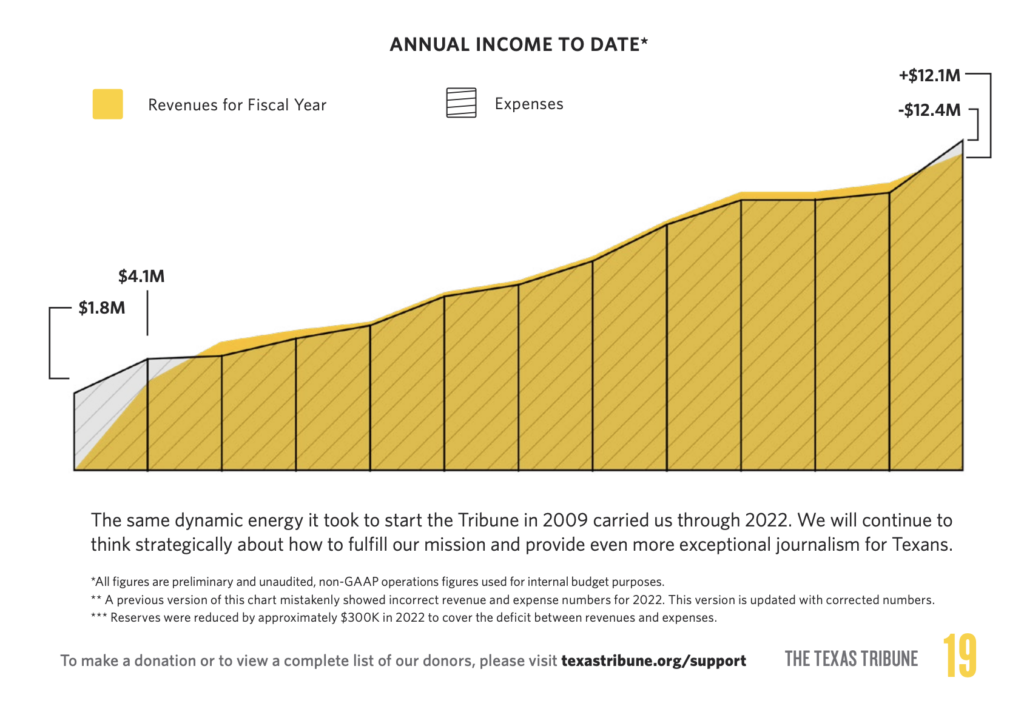CalMatters CEO on Texas Tribune layoffs: ‘Growing too fast is a danger, but so is standing still.’
CalMatters CEO Neil Chase shares more context on the mechanics of nonprofit revenue forecasting and fundraising.

CalMatters CEO Neil Chase posted this note in his organization’s Slack and gave LION permission to share it with some light editing. CalMatters is a LION member, and Neil is a LION board member.
People are unnerved by the Texas Tribune layoffs. That, to me, is appropriate. Anyone who’s not a little freaked out isn’t paying attention.
This is, unfortunately, a form of business cycle that affects nearly every company. Nonprofit is a tax status, not a business model, and nothing about being a nonprofit insulates us from the pressures of business cycles. That doesn’t mean cuts are inevitable, but it does mean you have to constantly look at how you’re spending and making money and make adjustments, and sometimes those are painful.
For instance, we’ve seen a lot of podcasts shut down after a couple of years. This is at a time when the industry thought podcasts were the next hot revenue stream, and some organizations built giant podcasting operations, only to learn that the only actual advertisers were mattress companies and the latest proposed miracle for saving journalism was as much of a mirage as the “pivot to video” or the BuzzFeed/Huffington Post insanely-high-traffic-and-banner-ads model. Would some of us say in retrospect that we could have seen that coming? Sure. Would we really have been confident enough in that vision to skip those trends? Eh, maybe.
I can’t authoritatively tell you what the Tribune should or could have done differently, if anything. I’ve heard things like, “It was stupid to budget higher revenue after a strong year and a CEO change,” but if they forecasted a lower budget for this year sooner, they would have had to make the cuts sooner. And it’s really hard to predict fundraising. Comparing their finances to ours is impossible without a deep dive into their books. This 2022 chart (see below) from The Texas Tribune’s Annual Report showing “revenue committed for this fiscal year” is how the accounting standards tell you to report it, but it doesn’t tell you anything about how much cash actually came in or how much they could expect to get in 2023 or 2024.

It’s impossible to compare apples to apples among nonprofits because every year is different and every organization is different.
For instance, we took in more than we spent last year. Several people said that if we had a good year, our raises should have been larger than they were. I wish we could have done that; the joy of running a nonprofit is that you get to put 100 percent of the money back into the business because there’s no f-ing bottom-feeding vulture hedge fund extracting 20 percent or more of it. (Ask me how I really feel.)
But the primary reason we had a surplus for last year is that one major donor, someone who had given about 8 percent of our annual budget over the past couple of years, told us 2022 would be her last year. She moved 100 percent of her philanthropy to have the maximum possible impact on a cause she’s now passionate about: food insecurity. That kind of shift is not unusual in philanthropy; it’s one of the reasons that nonprofit fundraising is hard.
Our Chief Development Officer Kate Looby and former Publisher and Chief Operating Officer Marcia Parker used some masterful fundraising jiu-jitsu to convince that donor to give us a smaller “step-down” amount in 2023 before winding down completely. To our great surprise, the donor sent it immediately, and it was another big gift. So our major-donor revenue for 2022 was higher than expected because of her large gift. We then budgeted less revenue in 2023 than in 2022, but that was fine because her extra money from 2022 covered the gap in our 2023 budget.
I’ve shared financial projections several times this year, which are unchanged. We’re on track to meet our 2023 budget and think we could break even without that extra 2022 gift covering the gap. That’s because, thanks to our development team’s hard work, we’ve brought in some new donors, and a couple of key ones increased their gifts. That would let us keep that 2022 gift in our reserves.
We’ll build our 2024 budget soon. That’s a painstaking project for the development team. They look at every existing and prospective donor and what they know about that person or organization’s donation history, their stated intent, and other factors to estimate how much they might give in 2024. On expenses, we’ll take into account lots of factors, like the current financial uncertainties (recession? inflation? rebound?), the election year, and the needs our Editor-in-Chief Kristen Go sees as she identifies gaps in our newsroom staffing. My guess is that we’ll budget for a slightly larger amount of revenue and an equal bump in expenses, projecting another break-even year.
Growing too fast is a danger, but so is standing still. People (readers, members, foundations, sources, peers, everyone) expect innovation and growth. If we get a grant to do something new, that’s not money we chose to spend on a new project. We were given money only because we proposed and wanted to do that new project. So it’s wrong to say that investing in Thing B and then having to cut Thing A was a bad decision; that money would not have been available for Thing A. Protecting Thing A is why it’s essential to keep a healthy amount of money in reserve. It doesn’t guarantee nothing ever changes; it just gives us months or years, instead of weeks, to gradually adjust and find new revenue if something does.
Our 2024 budget will include new experiments, likely including the ideas festival, a beefed-up TV presence that puts our coverage within reach of millions more households, more coverage in certain areas of the state, a more robust election guide and more activities to support it. None will be so big that they’ll hurt us badly if we don’t get the results we expect, but each is the kind of project you test and then decide whether to continue.
Just as we’ve learned from The Texas Tribune’s successes over the years, we’ll learn from their challenges. And we’ll continue to be the best partners we can to them and our other peer organizations, because we’re all in this together.
Learn more about CalMatters and its team.
Sign up for the weekly newsletter
Join the LION mailing list to get our weekly roundup of opportunities and resources for news entrepreneurs. View our most recent issues.
Related Articles
BoiseDev’s winning secret to selling newsletter ads: Only local news, only local ads
The site earns 60 percent of its advertising revenue through its high-open-rate email projects, in partnership with local ad agencies.
AI adoption: How Lede AI helps small publishers quickly generate content readers love
Helping news organizations leverage artificial intelligence with a tool that puts their readers and staff first
Social is down, newsletters are up: How audiences are finding LIONs in 2024
Changes to social media and search prompt publishers to shift strategy.
